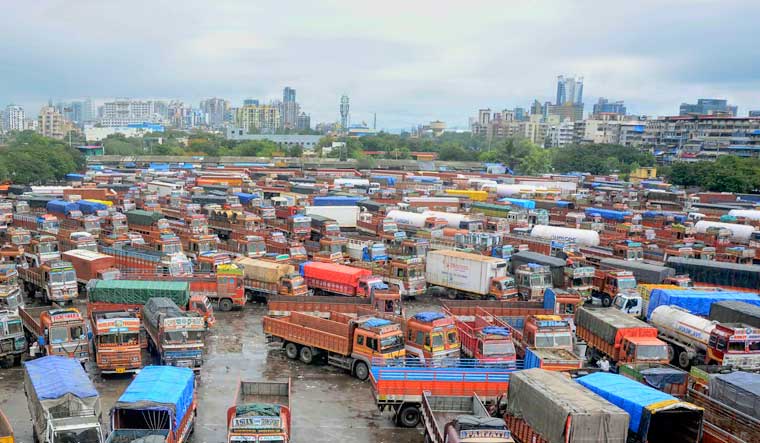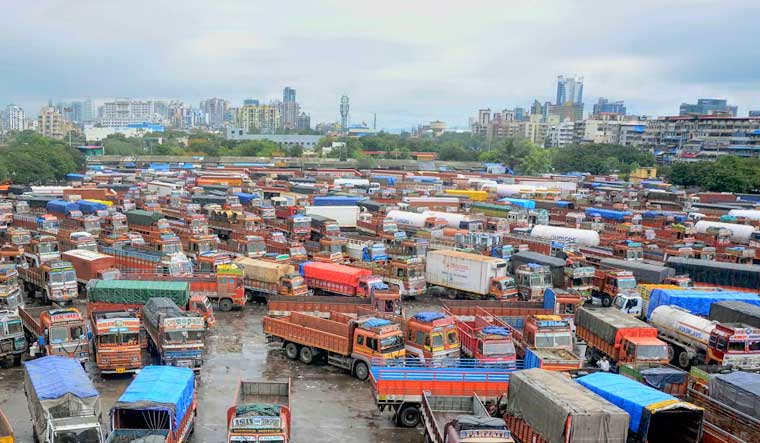
1. Transport strike leaves commuters in the lurch (07.08.2018)
Unions affiliated to AITUC, INTUC, IFTU TADS and JDAA are some of the unions that have planned the one-day strike across India. The worst affected will be the office employees and school or college students. The drivers are campaigning against raised challan and other fees. They chafe at the fact that the fines have since been raised to 1,000 from 100 for parking in prohibited zones. The fine for not having vehicle insurance has been raised from 250 to 5,000 and the fine for driving while holding a cellphone has also been raised from 100 to 5,000, a cab driver described.
Drivers are angry with such changes that ends special provisions for RTC and are auctioned on all the routes in India. They called on the government to withdraw Motor Vehicle amendment bill. Out of the 9,754 buses operational in the State, only 4% were plying on them; losses amounted to a crore and eleven lakhs. the leaders of the All-India Co-ordination Committee of Road Transport Workers Organisations declared a nation-wide transportation strike.
There was one day operators’ strike to protest against the regressive clauses of the Motor Vehicle Amendment Bill and the increase in prices of petroleum products. About 9,120 buses of the Telangana State Road Transport Corporation (TSRTC) across the State including in the State capital remained off the roads in the protest against the proposed changes in the Motor Vehicle Act leaving thousands of passengers to look for other means of transport.
The TSRTC employees were supported through the TSRTC Employees Union (TSRTCEU) and the National Mazdoor Union among others.
2. Drivers protest on new hit-&-run law impacts normal life (09.01.2024)
As the strike by the owners of the truck and bus threatened to paralyse life in the city, Maharashtra’s Chief Minister Eknath Shinde too directed all the district collectors to briefly meet the drivers to find the common ground and avoid inconvenience to people of the city. At the same time the opposition parties in the state supported the strike and drowning the need to amend the law which calls for 10 years imprisonment and a fine of Rs 10 lakh for hit and run cases under BNS.
A government official said that the government may take up the matter in the state Cabinet meeting scheduled for next Wednesday while state Industries Minister Uday Samant has urged the striking drivers to start negotiating with the state government and Centre.
Samant promised that the government will work out means of addressing the issue of the drivers after consulting with them and reaching a consensus. “The Centre and the state government will ensure the issue is resolved. In the end, it is for the heavy vehicles which are into the transportation of milk and vegetables, other such goods and even the essential commodities. The truck drivers’ organisations must, therefore, bear this in mind. The Centre and the state government will interfere in order to break the impasse.
3. 1974 Railway Strike
The Indian railway strike of 1974 was a large strike carried out by the employees of the Indian railways in 1974. The strike was between the 8th to the 27 of May in the year 1974. The 20-day strike by 1. 7 million (17 lakh) workers is the biggest-ever strike in the world of industrial relations.
The strike was observed to get the All-India Railwaymen’s Federation to get the locomotive staff to be granted an eight-hour working day and for pay scales to be raised for many years without change while pay scales of other government owned entities have risen through the years. Moreover, since British time the Railways referred the work of the locomotive staff as ‘continuous’, it meant that the workers would to remain on duty as long as the train was in operation on its journey possibly for several days at a time.
Even after gaining its freedom India had not been spared from, it. Despite India gaining its freedom in 1947, the Railway Board; a quasi-government bureaucracy had not put into practice eight-hour work day and this had result in discontent among labour, particularly the locomotive Pilot. Moreover, the so-called traditional railway union leaders were also slowly drifting away from their fellow workers and moving closer to the politicians and therefore exacerbating the conflict.
Since the sixties with the use of diesel engines and the subsequent increase in the working pressure on the Indian Railways, the working hours became continuous and were being extended by days which raised much indignation amongst the workers.
The Railways was still a government organization in which one of the internationally recognized rights – eight hours working day – was and remained violated with non-chalance. When the crafts unions brought the issue to the table, they were calling for a 12-hour work day for loco running staff. This led to railway strikes by rail workers across the country in 1967, 1968, 1970 and 1973, finally leading to the 1974 strike which was participated in by 70% of the permanent work force of railways.
This was not the first railways strike in India, the earliest having occurred in British India in 1862 in Howrah, and a number of strikes having occurred in the private railway companies that operated in British India, most of them becoming part of the Indian freedom struggle.
They were led by George Fernandes, the President of the All-India Railwaymen’s Federation.
The strike was initiated on 8 May 1974. This was severely put down by the then Indira Gandhi government where thousands were arrested and dismissed from their jobs. The strike was terminated on 27 May 1974.
4. Transport strike hits India’s Silicon Valley (11.09.23)
Tens of thousands of Uber and Ola call service taxis were off the roads of Bengaluru on Monday as part of a much broader transport strike that left school students and office workers stranded in India’s Silicon Valley city.
The strike was declared in response to the government scheme under which women can travel for free in non-AC government operated buses. Shabana Muhammad, a private transporter from Karachi, added that the CNG scheme had become unfavourable and had negatively impacted their earning. Uber and Ola people requested the journalists give them time to count the taxis that were off the roads, which is a city famous for its congestion. It now emerges that Bengaluru is one of the major markets for cab aggregators in India.
Some companies for instance Northern Trust had to allow their workers to open work from home while on their part, Nokia encouraged their workers to look for other means of transport. Even that our employee cab services also will be trouble shot during this strike and there will not be cabs available for our pick and drop service,” Nokia said in an internal communication shared with Reuters.
Eldho Basil John, who works with software firm Neutrinos, said that he was in desperate search of cabs for almost two hours starting from 8 am “there was no auto available and nobody was accepting it even Rapido which is a motorcycle app”. “I had to borrow my flatmate’s bike and rush to office”.
On the social media platform X, formerly known as Twitter, the public Bengaluru Metropolitan Transport Corporation added 4,000 extra bus routes in a bid to support desperate passengers, the company said.
5. Transporters’ strike affects 20 billion tonnes-km of freight traffic movement across India (07.10.2015)
Deficiency of vital products may raise their prices for 10-15% per day
The apex industry association ASSOCHAM urged the AIMTC to withdraw the indefinite strike which has already halted about 20 billion tonnes-km of freight transportation.
There is severe shortage of ‘food on wheels’ that and with over one crore trucks and tempos being on a strike since past five days the prices of essentials such as milk, fruits and vegetables have already gone up steeply and they are expected to go up by about 10-15 per cent per day more if the strike persists, revealed an ASSOCHAM economic research conducted on the financial impact of transporters’ strike.
In addition, the strike by truckers has also affected the state government revenues including road transport transport revenue more than Rs 3,600 lakh, it added.
Similarly, ASSOCHAM has also requested the union government to intervene to bring an end to a deadlock to support road transport as the percentage of high value, low volume traffic will only grow in the coming time.
For more updates, subscribe to our newsletter: https://thenewzzy.com/

